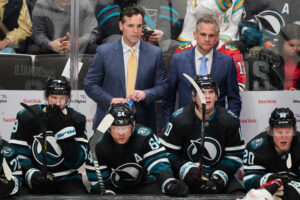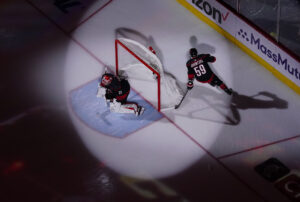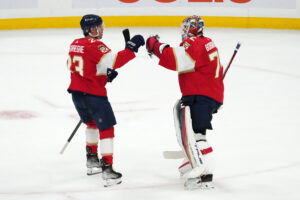Centred by Mika Zibanejad with Chris Kreider on the left and Pavel Buchnevich on the right, the “KZB” trio has been the top line of the New York Rangers for multiple seasons. While split up occasionally, they have been the mainstay starting forward line for the Rangers since 2017. Throughout the process, they developed chemistry and achieved much success together. However, with new additions to the forward core and the emergence of another trio on the team, perhaps Coach David Quinn should consider breaking up the KZB line.
Why The Rangers Should Consider Breaking Up The KZB Line
Uniting Zibanejad and Panarin
Many of the most successful teams in the league at the moment have superstar duos on the same line (the Avalanche with Nathan MacKinnon and Mikko Rantanen, the Bruins with Brad Marchand and David Pastrnak, and the Lightning with Nikita Kucherov and Brayden Point). The Rangers could utilize such a dynamic duo of their own.
The duo of Mika Zibanejad and Artemi Panarin would be just this for the Rangers. Zibanejad and Panarin only had short stints together, which never gave them a legitimate chance at even strength. They would usually be deployed together when the offence was struggling or when losing late in the third period. During these instances, the duo didn’t always stand out and produce like would be normally expected of them. However, when together on the powerplay or for overtime, they were truly a force to be reckoned with.
Their passing, shooting, and stickhandling abilities compliment each other so well on special teams, giving a reason to believe they could find success at even strength if given enough time together.
An Overlooked Trio
When Filip Chytil made his season debut on October 29th due to Zibanejad’s sustained injury, he was immediately placed on the second line centring Chris Kreider and Pavel Buchnevich. Their first game together was against one of the top teams in the league and the eventual Stanley Cup champions, Tampa Bay Lightning. Chytil scored the game-winning goal off a great feed from Buchnevich. Kreider was also on the rush as a threatening pass option that opened room for the scoring play. The new trio combined for 7 shots on goal in this game where the Rangers lead in the shots on goal department for the first time in the season. Uncoincidentally, this was also the first time where they had dominated the expected-goals share since the beginning of the season. Clearly, the line of Kreider, Chytil, and Buchnevich was off to a great start.
As their time together progressed, they maintained their incredible play driving abilities, ranking 9th in the league in xGF% among forward lines who played at least 110 minutes together. Although the sample sizes differ, the comparison between the KCB and KZB trio is quite intriguing with the KCB line leading the KZB line in xGF% by 8.4%.
To see visually just how great 20-72-89 was, below is a chart that illustrates the Ranger’s forward lines and defensive pairs by expected-goals rates. Furthest in the top right lies the KCB line on an island of their own, showing just how dominant they were together.
Chytil and Buchnevich’s Chemistry
The main reason why this line was so special was due to the chemistry between Filip Chytil and Pavel Buchnevich. While Chris Kreider was also a very compatible member, the duo of Chytil and Buchnevich just clicked at another level.
As portrayed on the heat charts, the Rangers’ expected-goals shares improve 36% with Chytil and Buchnevich together. This drastic offensive increase is self-evident. Also, the expected-goals against shares do not worsen. This is especially meaningful as the Rangers generally sacrifice defence for offence, but that is not the case here.
Welcome Company
In 2021, wingers Kaapo Kakko and Alexis Lafreniere will be looking to solidify large roles on the team. Both players would be hoping for roles in the top-six.
Kakko, drafted 2nd overall in 2019, will be looking to make progress after a disappointing rookie year. Since Kakko plays on the right, his odds for a top-six role are higher due to the departure of Jesper Fast. His WAR (wins-above-replacement) was 4th to last amongst all skaters last year, but he certainly has the skillset to improve. Considering the months of training, lack of competition, and his name-value, Kakko is essentially slotted in as a top-six right-winger.
Lafreniere, drafted 1st overall in 2020, will be looking to start his career off with contributions coming right away. As a left-winger, Panarin and Kreider are both in front of Lafreniere, at least to start the year off. Even with his extraordinary playmaking and hockey IQ, he will most likely start on the 3rd line.
With a newly refurbished Kakko and potential franchise-calibre talent in Lafreniere being welcomed to the forward core, the Rangers should consider exploring different lineup possibilities.
Outlook
If the Rangers chose to separate the “KZB” trio and reunite the “KCB,” a lot would change on the offence. For starters, it would likely mean separating Panarin from Ryan Strome, who would be bumped down. While Strome and Panarin found great success together, the upside of what he could accomplish alongside Zibanejad is an opportunity worth contemplating.
On the contrary, there was nothing particularly broken on the Rangers’ top-six. So, one may question why a change is necessary.
Regardless of how they chose to go, here is how the Rangers forward lines would look with the KZB separated and the KCB reunited:
Artemi Panarin – Mika Zibanejad – Kaapo Kakko
Chris Kreider – Filip Chytil – Pavel Buchnevich
Alexis Lafreniere – Ryan Strome – Julien Guathier
Brendan Lemieux – Brett Howden – Phil Di Giusuppe
Main Photo:






